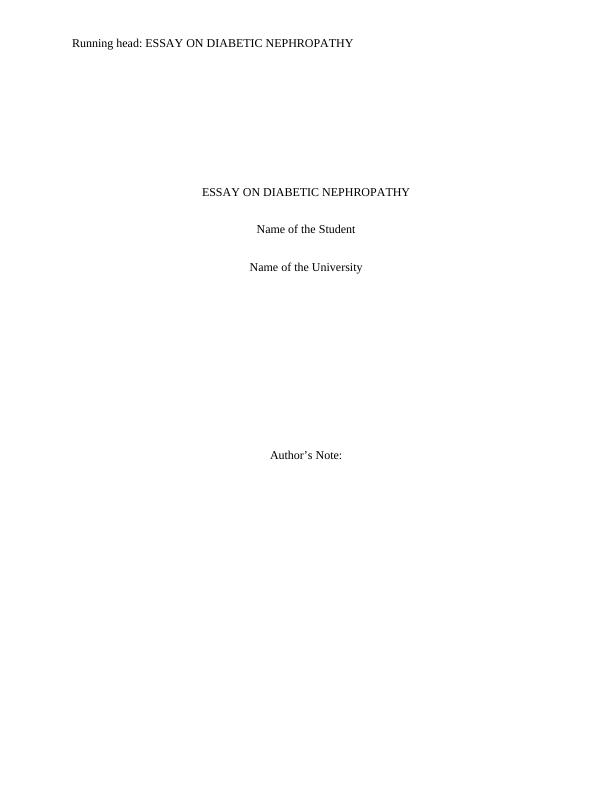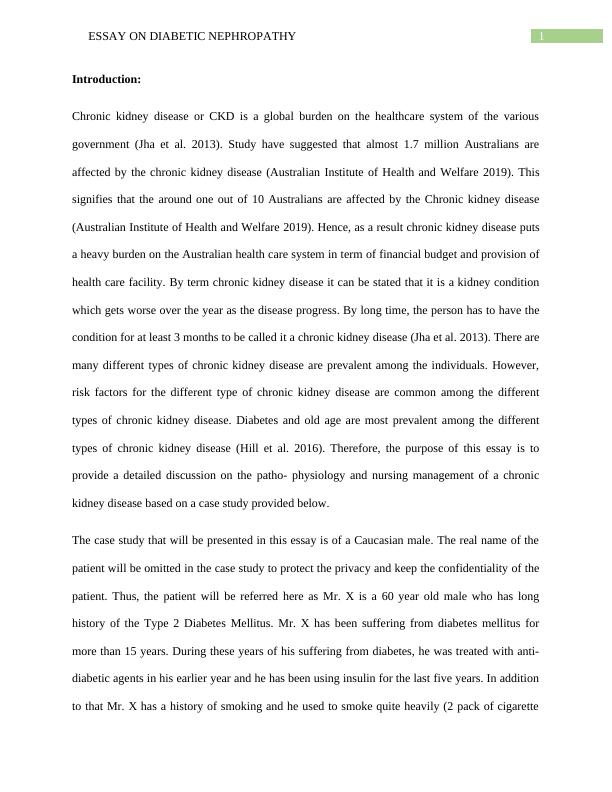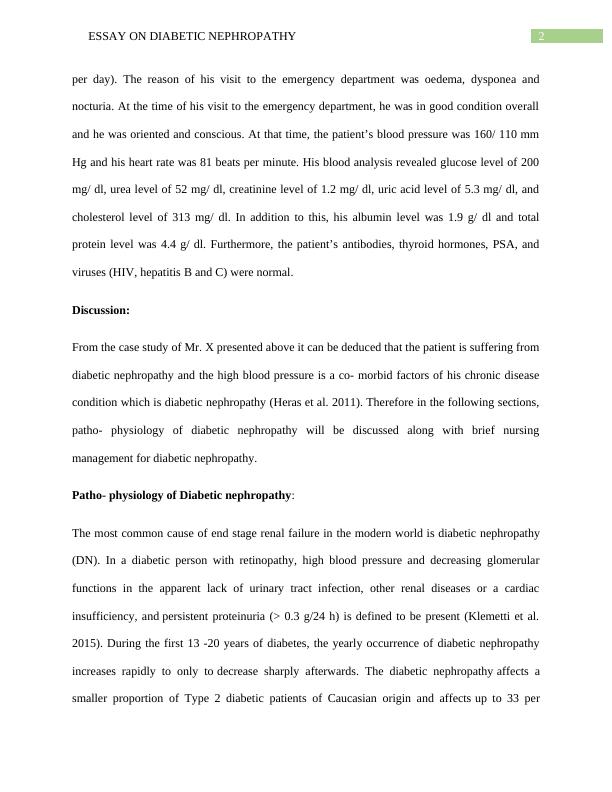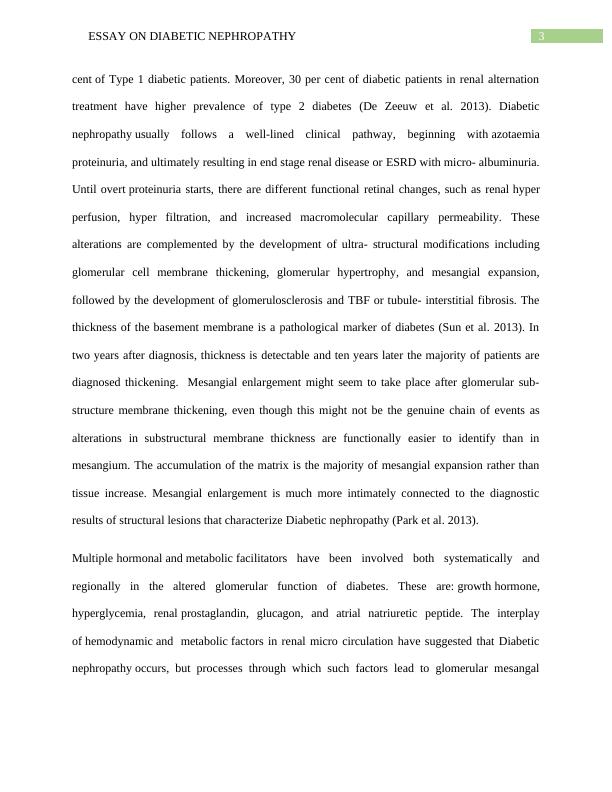Essay on Diabetic Nephropathy
Page 1 of 11 PDF.js viewer
14 Pages3356 Words129 Views
Added on 2023-04-05
About This Document
This essay provides a detailed discussion on the pathophysiology and nursing management of diabetic nephropathy based on a case study. Learn about the causes, metabolic pathways, and hemodynamic imbalances of diabetic nephropathy.
Essay on Diabetic Nephropathy
Page 1 of 11 PDF.js viewer
Added on 2023-04-05
ShareRelated Documents
Running head: ESSAY ON DIABETIC NEPHROPATHY
ESSAY ON DIABETIC NEPHROPATHY
Name of the Student
Name of the University
Author’s Note:
ESSAY ON DIABETIC NEPHROPATHY
Name of the Student
Name of the University
Author’s Note:

1ESSAY ON DIABETIC NEPHROPATHY
Introduction:
Chronic kidney disease or CKD is a global burden on the healthcare system of the various
government (Jha et al. 2013). Study have suggested that almost 1.7 million Australians are
affected by the chronic kidney disease (Australian Institute of Health and Welfare 2019). This
signifies that the around one out of 10 Australians are affected by the Chronic kidney disease
(Australian Institute of Health and Welfare 2019). Hence, as a result chronic kidney disease puts
a heavy burden on the Australian health care system in term of financial budget and provision of
health care facility. By term chronic kidney disease it can be stated that it is a kidney condition
which gets worse over the year as the disease progress. By long time, the person has to have the
condition for at least 3 months to be called it a chronic kidney disease (Jha et al. 2013). There are
many different types of chronic kidney disease are prevalent among the individuals. However,
risk factors for the different type of chronic kidney disease are common among the different
types of chronic kidney disease. Diabetes and old age are most prevalent among the different
types of chronic kidney disease (Hill et al. 2016). Therefore, the purpose of this essay is to
provide a detailed discussion on the patho- physiology and nursing management of a chronic
kidney disease based on a case study provided below.
The case study that will be presented in this essay is of a Caucasian male. The real name of the
patient will be omitted in the case study to protect the privacy and keep the confidentiality of the
patient. Thus, the patient will be referred here as Mr. X is a 60 year old male who has long
history of the Type 2 Diabetes Mellitus. Mr. X has been suffering from diabetes mellitus for
more than 15 years. During these years of his suffering from diabetes, he was treated with anti-
diabetic agents in his earlier year and he has been using insulin for the last five years. In addition
to that Mr. X has a history of smoking and he used to smoke quite heavily (2 pack of cigarette
Introduction:
Chronic kidney disease or CKD is a global burden on the healthcare system of the various
government (Jha et al. 2013). Study have suggested that almost 1.7 million Australians are
affected by the chronic kidney disease (Australian Institute of Health and Welfare 2019). This
signifies that the around one out of 10 Australians are affected by the Chronic kidney disease
(Australian Institute of Health and Welfare 2019). Hence, as a result chronic kidney disease puts
a heavy burden on the Australian health care system in term of financial budget and provision of
health care facility. By term chronic kidney disease it can be stated that it is a kidney condition
which gets worse over the year as the disease progress. By long time, the person has to have the
condition for at least 3 months to be called it a chronic kidney disease (Jha et al. 2013). There are
many different types of chronic kidney disease are prevalent among the individuals. However,
risk factors for the different type of chronic kidney disease are common among the different
types of chronic kidney disease. Diabetes and old age are most prevalent among the different
types of chronic kidney disease (Hill et al. 2016). Therefore, the purpose of this essay is to
provide a detailed discussion on the patho- physiology and nursing management of a chronic
kidney disease based on a case study provided below.
The case study that will be presented in this essay is of a Caucasian male. The real name of the
patient will be omitted in the case study to protect the privacy and keep the confidentiality of the
patient. Thus, the patient will be referred here as Mr. X is a 60 year old male who has long
history of the Type 2 Diabetes Mellitus. Mr. X has been suffering from diabetes mellitus for
more than 15 years. During these years of his suffering from diabetes, he was treated with anti-
diabetic agents in his earlier year and he has been using insulin for the last five years. In addition
to that Mr. X has a history of smoking and he used to smoke quite heavily (2 pack of cigarette

2ESSAY ON DIABETIC NEPHROPATHY
per day). The reason of his visit to the emergency department was oedema, dysponea and
nocturia. At the time of his visit to the emergency department, he was in good condition overall
and he was oriented and conscious. At that time, the patient’s blood pressure was 160/ 110 mm
Hg and his heart rate was 81 beats per minute. His blood analysis revealed glucose level of 200
mg/ dl, urea level of 52 mg/ dl, creatinine level of 1.2 mg/ dl, uric acid level of 5.3 mg/ dl, and
cholesterol level of 313 mg/ dl. In addition to this, his albumin level was 1.9 g/ dl and total
protein level was 4.4 g/ dl. Furthermore, the patient’s antibodies, thyroid hormones, PSA, and
viruses (HIV, hepatitis B and C) were normal.
Discussion:
From the case study of Mr. X presented above it can be deduced that the patient is suffering from
diabetic nephropathy and the high blood pressure is a co- morbid factors of his chronic disease
condition which is diabetic nephropathy (Heras et al. 2011). Therefore in the following sections,
patho- physiology of diabetic nephropathy will be discussed along with brief nursing
management for diabetic nephropathy.
Patho- physiology of Diabetic nephropathy:
The most common cause of end stage renal failure in the modern world is diabetic nephropathy
(DN). In a diabetic person with retinopathy, high blood pressure and decreasing glomerular
functions in the apparent lack of urinary tract infection, other renal diseases or a cardiac
insufficiency, and persistent proteinuria (> 0.3 g/24 h) is defined to be present (Klemetti et al.
2015). During the first 13 -20 years of diabetes, the yearly occurrence of diabetic nephropathy
increases rapidly to only to decrease sharply afterwards. The diabetic nephropathy affects a
smaller proportion of Type 2 diabetic patients of Caucasian origin and affects up to 33 per
per day). The reason of his visit to the emergency department was oedema, dysponea and
nocturia. At the time of his visit to the emergency department, he was in good condition overall
and he was oriented and conscious. At that time, the patient’s blood pressure was 160/ 110 mm
Hg and his heart rate was 81 beats per minute. His blood analysis revealed glucose level of 200
mg/ dl, urea level of 52 mg/ dl, creatinine level of 1.2 mg/ dl, uric acid level of 5.3 mg/ dl, and
cholesterol level of 313 mg/ dl. In addition to this, his albumin level was 1.9 g/ dl and total
protein level was 4.4 g/ dl. Furthermore, the patient’s antibodies, thyroid hormones, PSA, and
viruses (HIV, hepatitis B and C) were normal.
Discussion:
From the case study of Mr. X presented above it can be deduced that the patient is suffering from
diabetic nephropathy and the high blood pressure is a co- morbid factors of his chronic disease
condition which is diabetic nephropathy (Heras et al. 2011). Therefore in the following sections,
patho- physiology of diabetic nephropathy will be discussed along with brief nursing
management for diabetic nephropathy.
Patho- physiology of Diabetic nephropathy:
The most common cause of end stage renal failure in the modern world is diabetic nephropathy
(DN). In a diabetic person with retinopathy, high blood pressure and decreasing glomerular
functions in the apparent lack of urinary tract infection, other renal diseases or a cardiac
insufficiency, and persistent proteinuria (> 0.3 g/24 h) is defined to be present (Klemetti et al.
2015). During the first 13 -20 years of diabetes, the yearly occurrence of diabetic nephropathy
increases rapidly to only to decrease sharply afterwards. The diabetic nephropathy affects a
smaller proportion of Type 2 diabetic patients of Caucasian origin and affects up to 33 per

3ESSAY ON DIABETIC NEPHROPATHY
cent of Type 1 diabetic patients. Moreover, 30 per cent of diabetic patients in renal alternation
treatment have higher prevalence of type 2 diabetes (De Zeeuw et al. 2013). Diabetic
nephropathy usually follows a well-lined clinical pathway, beginning with azotaemia
proteinuria, and ultimately resulting in end stage renal disease or ESRD with micro- albuminuria.
Until overt proteinuria starts, there are different functional retinal changes, such as renal hyper
perfusion, hyper filtration, and increased macromolecular capillary permeability. These
alterations are complemented by the development of ultra- structural modifications including
glomerular cell membrane thickening, glomerular hypertrophy, and mesangial expansion,
followed by the development of glomerulosclerosis and TBF or tubule- interstitial fibrosis. The
thickness of the basement membrane is a pathological marker of diabetes (Sun et al. 2013). In
two years after diagnosis, thickness is detectable and ten years later the majority of patients are
diagnosed thickening. Mesangial enlargement might seem to take place after glomerular sub-
structure membrane thickening, even though this might not be the genuine chain of events as
alterations in substructural membrane thickness are functionally easier to identify than in
mesangium. The accumulation of the matrix is the majority of mesangial expansion rather than
tissue increase. Mesangial enlargement is much more intimately connected to the diagnostic
results of structural lesions that characterize Diabetic nephropathy (Park et al. 2013).
Multiple hormonal and metabolic facilitators have been involved both systematically and
regionally in the altered glomerular function of diabetes. These are: growth hormone,
hyperglycemia, renal prostaglandin, glucagon, and atrial natriuretic peptide. The interplay
of hemodynamic and metabolic factors in renal micro circulation have suggested that Diabetic
nephropathy occurs, but processes through which such factors lead to glomerular mesangal
cent of Type 1 diabetic patients. Moreover, 30 per cent of diabetic patients in renal alternation
treatment have higher prevalence of type 2 diabetes (De Zeeuw et al. 2013). Diabetic
nephropathy usually follows a well-lined clinical pathway, beginning with azotaemia
proteinuria, and ultimately resulting in end stage renal disease or ESRD with micro- albuminuria.
Until overt proteinuria starts, there are different functional retinal changes, such as renal hyper
perfusion, hyper filtration, and increased macromolecular capillary permeability. These
alterations are complemented by the development of ultra- structural modifications including
glomerular cell membrane thickening, glomerular hypertrophy, and mesangial expansion,
followed by the development of glomerulosclerosis and TBF or tubule- interstitial fibrosis. The
thickness of the basement membrane is a pathological marker of diabetes (Sun et al. 2013). In
two years after diagnosis, thickness is detectable and ten years later the majority of patients are
diagnosed thickening. Mesangial enlargement might seem to take place after glomerular sub-
structure membrane thickening, even though this might not be the genuine chain of events as
alterations in substructural membrane thickness are functionally easier to identify than in
mesangium. The accumulation of the matrix is the majority of mesangial expansion rather than
tissue increase. Mesangial enlargement is much more intimately connected to the diagnostic
results of structural lesions that characterize Diabetic nephropathy (Park et al. 2013).
Multiple hormonal and metabolic facilitators have been involved both systematically and
regionally in the altered glomerular function of diabetes. These are: growth hormone,
hyperglycemia, renal prostaglandin, glucagon, and atrial natriuretic peptide. The interplay
of hemodynamic and metabolic factors in renal micro circulation have suggested that Diabetic
nephropathy occurs, but processes through which such factors lead to glomerular mesangal

End of preview
Want to access all the pages? Upload your documents or become a member.
Related Documents
QUALITY USE OF MEDICINES DOCX.lg...
|5
|2383
|14
THE CRITICAL THINKING ESSAYlg...
|8
|1768
|14
Acute Coronary Syndrome: A Case Study of Thomas with Multiple Health Complicationslg...
|11
|2781
|459
The rate of other chronic health issuelg...
|9
|2700
|11
Diabetes Needs Assessment in a Community with Identified Areaslg...
|11
|3224
|207
Renal Transplant: Procedure, Anatomy and Physiology of Kidney, and Potential Complicationslg...
|13
|4195
|491
